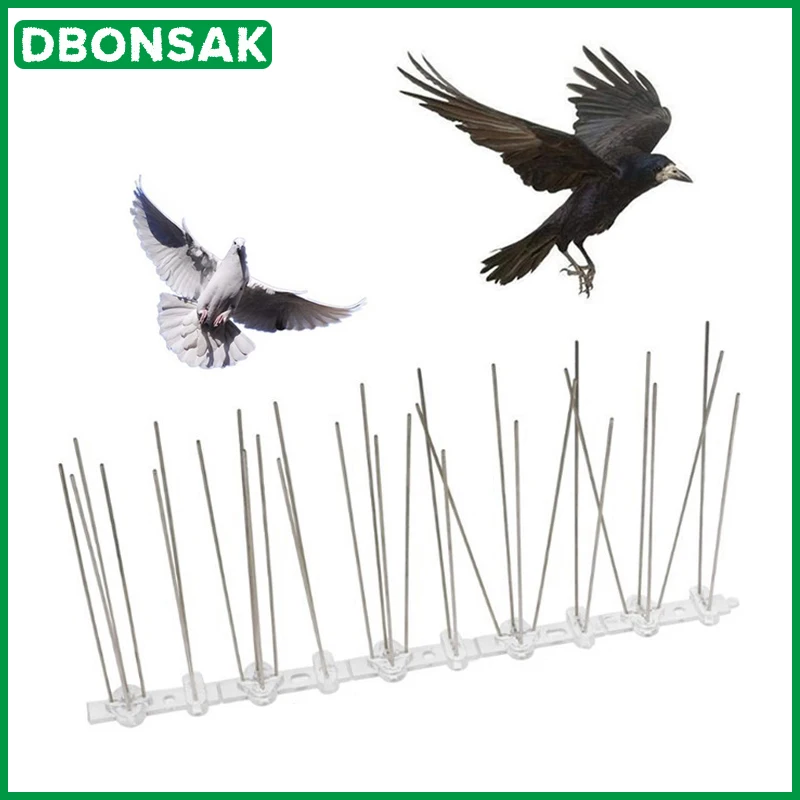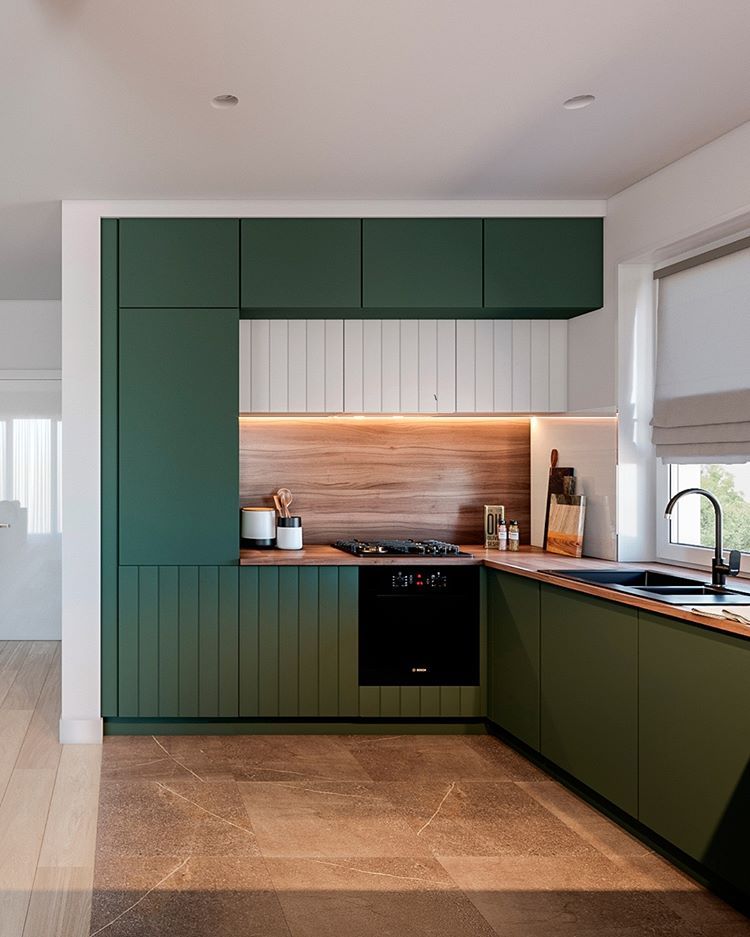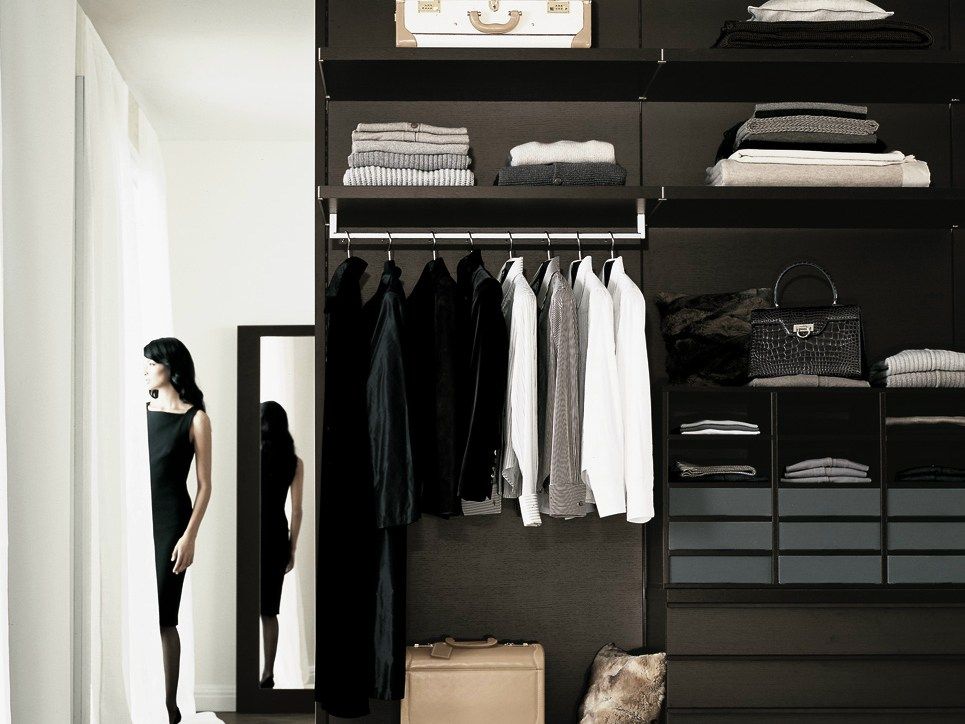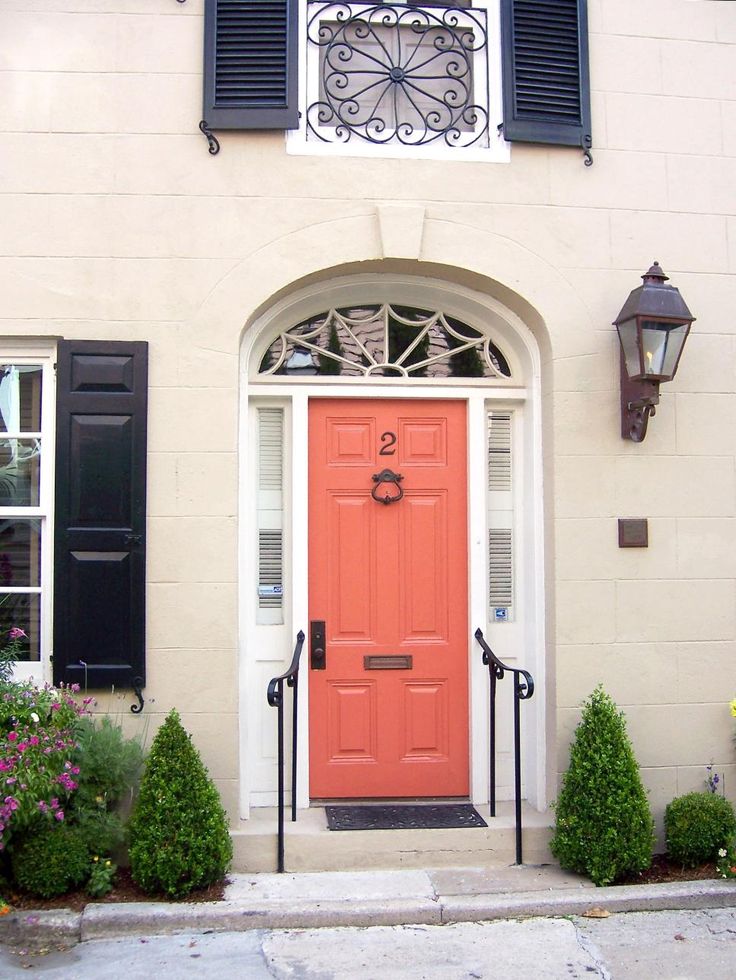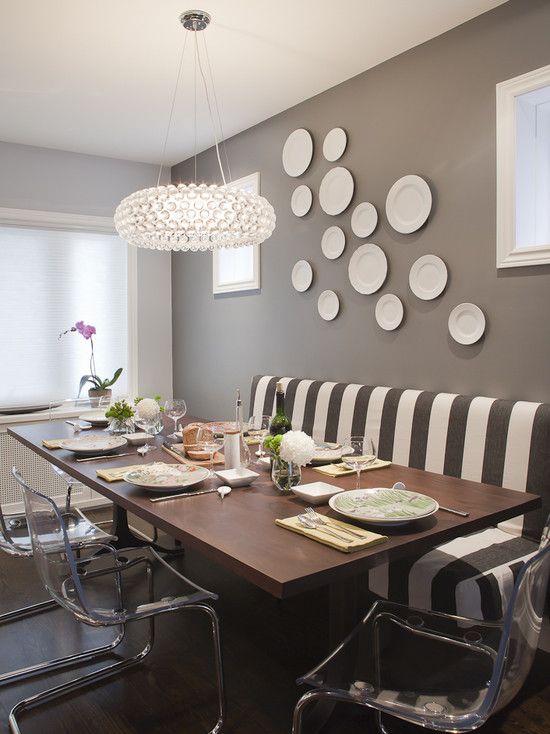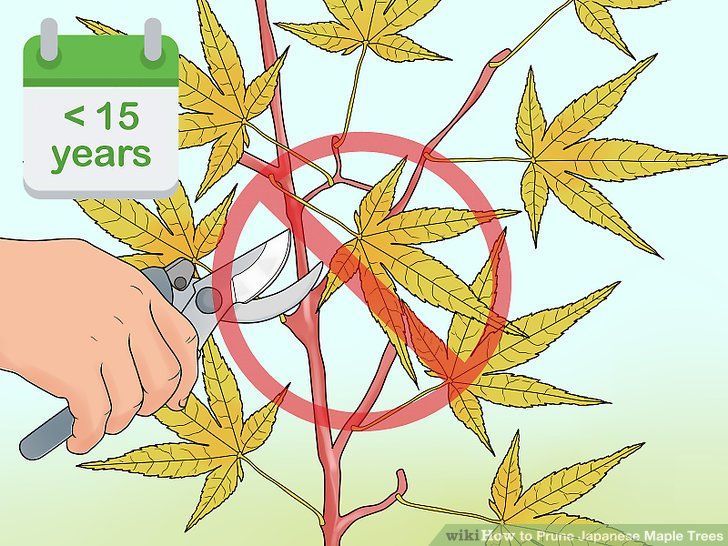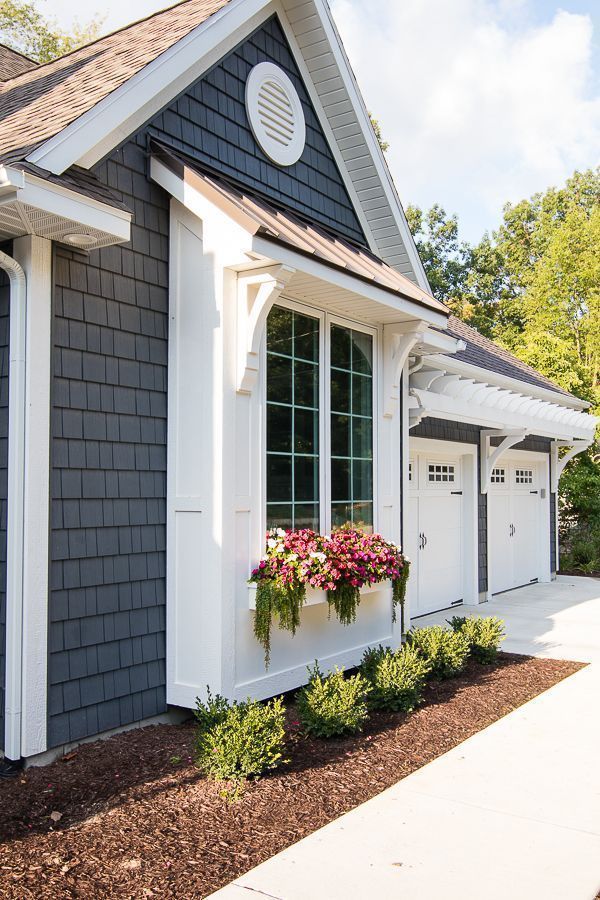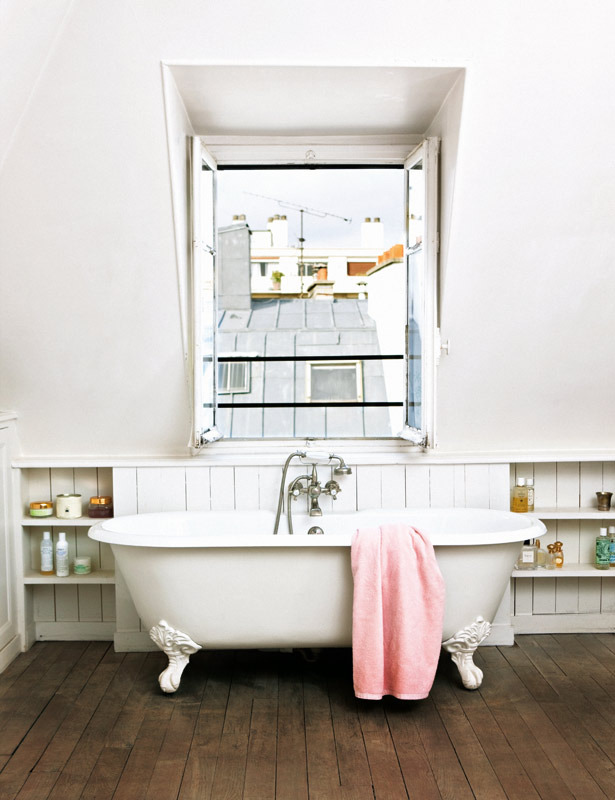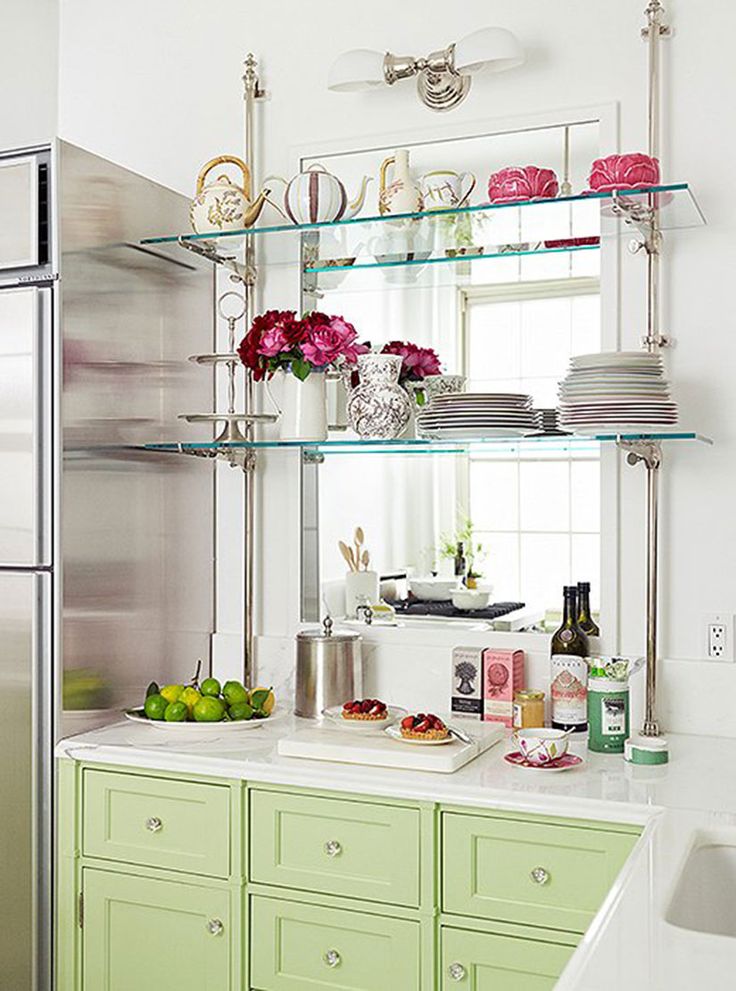Get rid of pigeon
How to Get Rid of Pigeons
“one pigeon is no problem….
the problem is there is no such thing as one pigeon”
One of the most common questions that people with pigeon problems ask is how to get rid of the birds from roofs, balconies, and industrial facilities. The pigeons are causing at best an inconvenience and at worst a health hazard. Irrespective of the mess, pigeon feces are corrosive and can etch through steel or even concrete.
In this article, we will discuss how to get rid of pigeons using different methods, so that you can easily find the best solution for your scenario.
Table Of ContentsHow to Get Rid of Pigeons
Comparison Table of 5 Main Control Solutions
Get Rid of Pigeons from a Balcony
Get Rid of Pigeons from a Roof
Get Rid of Pigeons at Industrial Facilities
Conclusion
How to Get Rid of Pigeons?
1.
Culling Pigeons
- this method includes shooting, poisoning, using traps and even raptors
2.
Reducing Pigeon Reproduction
- this method includes using pigeon birth control, nest destruction and dovecotes combined with egg removal or replacement
3.
Physically Excluding Pigeons
- this method includes using spikes, wires, slides and shock tracks to keep pigeons away
4.
Using Deterrents
-this method includes sonic and ultrasonic emitters, effigies, reflected and direct light sources, propane cannons and trained raptors to deter pigeons
5.
Using Repellents
- this method includes using gels and pastes, optical gels, fogs and vapors to deter pigeons
If you have a pigeon problem in industrial or large areas, Contact us!
Comparison Table of 5 Main Methods to Get Rid of Pigeons
| Method/Product | Best Used For | Advantages | Disadvantages |
| Culling | |||
| Shoot | Killing birds | Immediate action, low cost | Generally prohibited in public.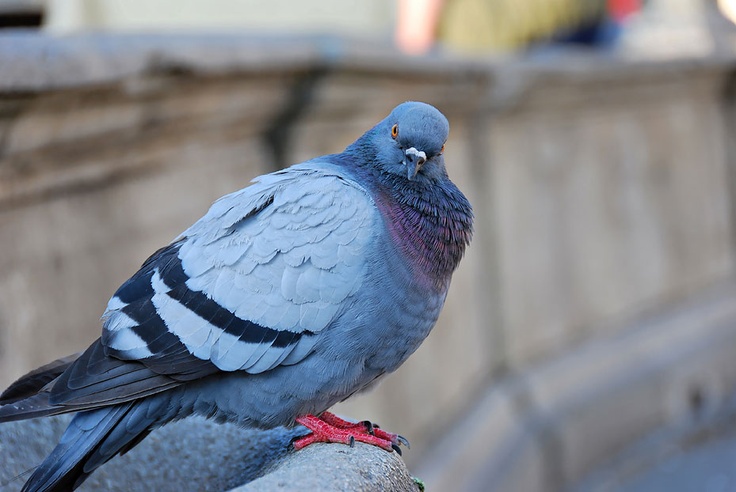 Represents a harvest as opposed to a control program Represents a harvest as opposed to a control program |
| Poison | Killing birds | Immediate action | Non-target risks; socially unacceptable, short-term solution; dead and dying birds |
| Trap and euthanize | Killing birds | Immediate action | Often unacceptable where people are present. Short-term effects; birds get “trap shy” |
| Raptors | Predator and prey | Pigeons are a natural prey species; environmentally sound solution | Mating pairs are difficult to attract under most urban conditions. Raptors migrate and will leave the area part of the year |
| Reduce Reproduction | |||
| Birth Control | Abatement alternative | Gradually but predictably unwinds the pigeon population | Takes some time to work |
| Nest destruction | Destroy individual nests | Best for a small number of nests where exclusion will be installed | Completely ineffective since the mating pair will just build new ones.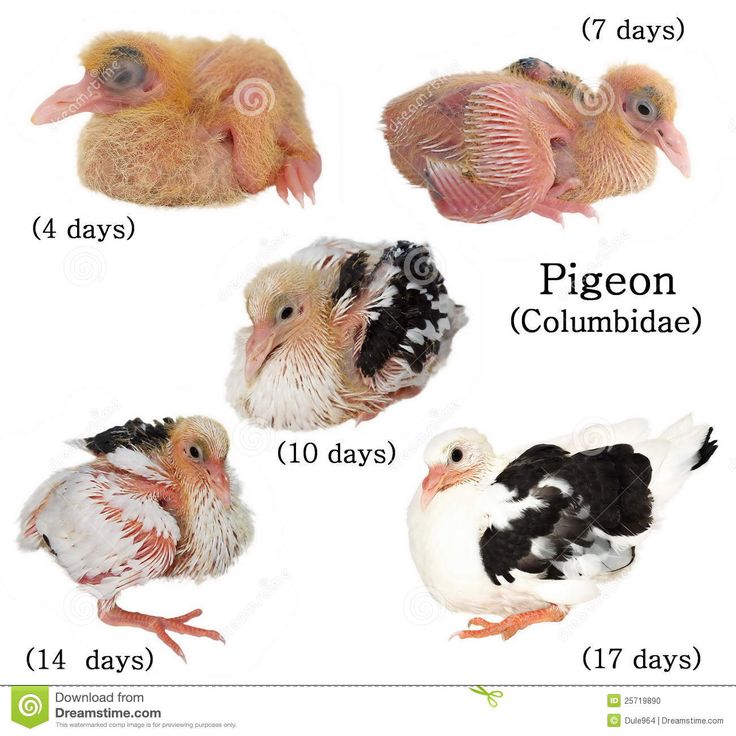 |
| Dovecots combined with egg removal or replacement | Commune with nature in a park | Provides a safe and secure way of harvesting eggs | Ineffective at controlling a population of pigeons; only provides extra housing for the birds. |
| Physical Exclusion | |||
| Spikes | Rails, perching areas | Inexpensive; can be highly effective under the right set of conditions; easy installation | In best case, will only move birds to the next best location |
| Bird Wire | Rails, fences, rooflines, perching areas | Useful tool to keep pigeons off perching areas. | More complex installation especially on rooflines |
| Slides | Narrow perching areas | Inexpensive and relatively easy installation | Only suitable under the appropriate conditions where a slide can be installed. |
| Netting | Gold standard for physically excluding birds from both large and small areas and structures | Tangible and immediate effect; can represent a permanent fix for problem birds.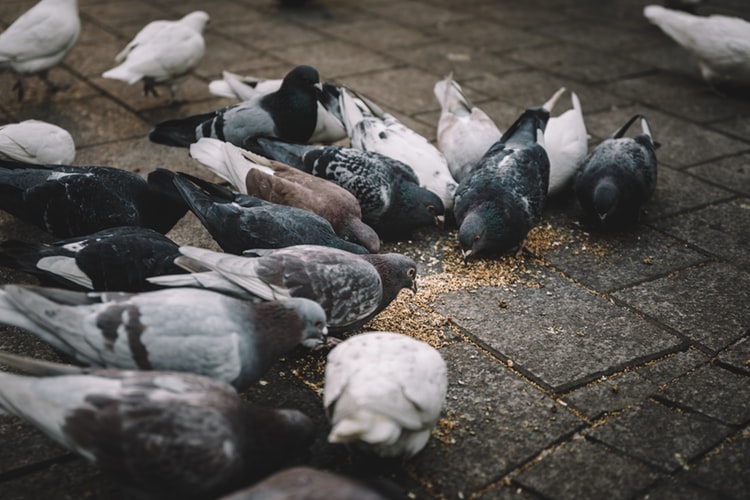 | Costly installation requiring professionals. Moves the problem to neighboring structures or facilities |
| Shock track systems | Rails, perching and loafing areas and surfaces | Highly effective in keeping birds off landing and perching areas | Equipment can be complex. Professional installation normally required. More costly than spikes |
| Deterrents | |||
| Sonic and ultrasonic emitters | Aural harassment | Can be used in larger areas where exclusion is not practical | Birds acclimate to the sounds |
| Effigies – plastic owl, rubber snake | Visual harassment | Can be effective short term | Birds acclimate to effigies |
| Reflected and direct light sources | Visual harassment | Can be effective long-term under appropriate conditions | Costs have a wide range; from shiny pie plates or CD’s to industrial lasers |
| Propane cannon | Harassment | Tangible and immediate effects | Birds acclimate and eventually ignore the noise; not suitable for urbanized areas |
| Trained raptors | Harassment with predators | Pigeons will flee raptors | Pigeons come right back when the birds of prey go home |
| Repellents | |||
| Gels and pastes | Perching areas | Inexpensive | Can kill smaller birds; requires consistent reapplication |
| Optical Gel | Perching and loafing areas | Small and inexpensive; easy to install | Not necessarily appropriate for larger areas. Intensive cleaning required. Intensive cleaning required. |
| Fogs and vapors | Large indoor areas | Ideal for large volume structures | Inconsistent action |
How to Get Rid of Pigeons from a Balcony
Getting rid of pigeons from small areas like balconies can be resolved with relatively simple common-sense solutions.
Wires. You can use a wire coil or stainless-steel wire to deter pigeons perching on rails.
Shock Track. Several suppliers offer a “shock track” system to keep birds off balconies. The shock track does not hurt the bird but provides enough stimulation to make the targeted perching area unattractive.
Netting. Consider using a netting system to physically exclude the birds from balconies. This is the costliest alternative, although if installed properly it's 100% effective. Newer versions of netting are virtually invisible.
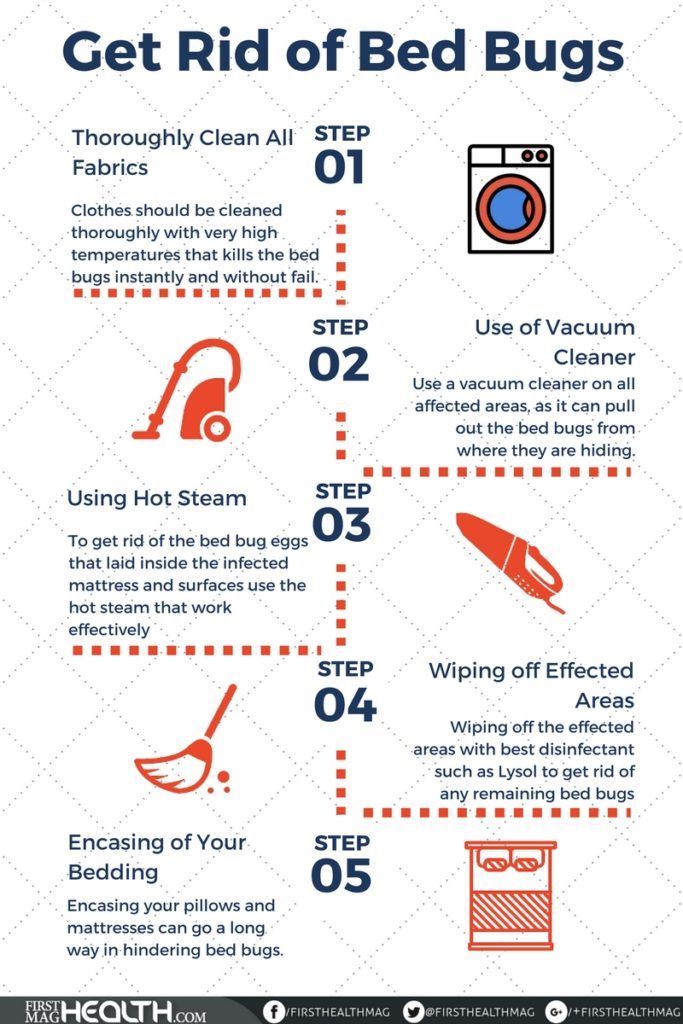
Sound or reflected light. The easiest way to deter pigeons from your patio, deck, or balcony, is with sound or reflected light. You can achieve this with a wind chime, Mylar balloon, aluminum foil pans or even hanging CD’s. The reflected light disorients the birds.
Plastic owl or rubber snake. Consider using scarecrows (“effigies”). The most common example is a plastic owl or rubber snake. Unfortunately, the effects will most likely be short-lived. The pigeons come to recognize the scarecrow as something that is not a threat.
Spikes. Consider using anti-perching spikes that you can attach anywhere the birds like to perch. Spikes are best advised for limited areas where the goal is to move the birds someplace else. They are available in different materials from plastic to stainless steel.
Gel Repellants. You can use gel repellants to ledges where pigeons perch.
 The gel makes the surface sticky and the birds will try to avoid it. Unfortunately, dust and debris take their toll and reapplication is often necessary. The application of gel repellants is not recommended where there are smaller birds. They can permanently get stuck in the goo
The gel makes the surface sticky and the birds will try to avoid it. Unfortunately, dust and debris take their toll and reapplication is often necessary. The application of gel repellants is not recommended where there are smaller birds. They can permanently get stuck in the goo
How to Get Rid of Pigeons on Roofs
If you have a pigeon problem on your roof, there are a few things you can do to get rid of them. First, try to figure out how they are getting onto your roof in the first place. If you have any holes or cracks that they can use as an entry point, seal them up with some wire mesh or caulking. You can also try installing a physical barrier like a wire fence around the perimeter of your roof.
Keeping pigeons off a roof can be far more challenging. Here are some popular methods you might consider if you wonder how to get rid of pigeons on roofs:
Consider using a wire coil or stainless-steel wire to deter pigeons from perching on the ridge(s).

A “shock track” system might keep birds off rooftops
Using wire or netting is appropriate for a roof design that incorporates nooks. You can also apply nets where the pigeons can construct a nest.
Solar panels provide excellent harborage for pigeons. Metal grid netting is the most effective method to limit access to the birds.
Flat commercial roof styles have their own set of challenges. The first option is to electrify the parapet perching areas. The second option is to install simple spikes. Be aware that pigeons enjoy the comfort of HVAC installations. As a solution, consider netting these units.
How to Get Rid of Pigeons at Industrial Facilities
The basic nature and scope of modern industrial facilities make them highly attractive to pigeons. The design of these facilities is most often open which allows the birds ready ingress and egress. More importantly, pipes, beams, poles, and catwalks offer a wide range of harborage and nesting options.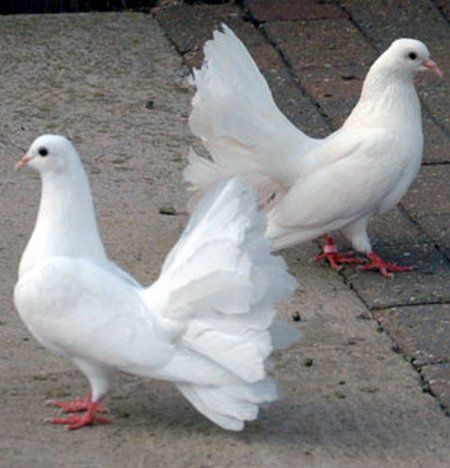 Food sources are typically located nearby and as mobile pests, pigeons can move around freely from one area of the plant to the next.
Food sources are typically located nearby and as mobile pests, pigeons can move around freely from one area of the plant to the next.
Pigeons can represent a costly nuisance for plants, and in many cases have been at the facility ever since it was built. Over time, the nests, feces, and debris can cause considerable damage to a plant’s mechanical and electrical components. Furthermore, the birds’ droppings and other debris add additional health hazards to an already hazardous area.
Most conventional methods of pigeon mitigation offer little comfort to an industrial facility and decision makers often select culling solutions since everything else is either prohibitively costly or impractical. Methods such as trapping and poisoning the birds may help alleviate the problem temporarily, however, due to their rapid breeding, pigeons always return and repopulate the very attractive site in a few weeks or months.
While highly effective at smaller sites, physical exclusion is typically not an option at a larger plant.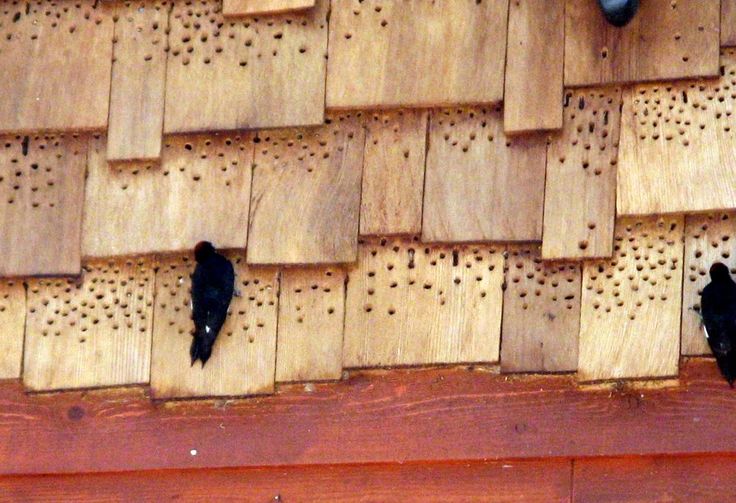 It is simply impossible to cover an oil refinery or power plant with a net.
It is simply impossible to cover an oil refinery or power plant with a net.
The more common solutions for smaller scale facilities are only appropriate for the resolution of isolated problems at a larger plant. An area where there is zero tolerance for birds mandates physical exclusion to keep them out, while the overall control strategy needs to focus on abatement.
The following graphic provides an outline of the various options for bird abatement. There are just two alternatives:
Increase mortality with the common culling methods, trap, shoot or poison
Reduce reproduction with a contraceptive.
The most effective method at a complex installation is a control program based on OvoControl. A contraceptive has exceptional utility in these large sites where conventional bird control methods may not be appropriate or cost effective.
While baiting birds without killing them may seem counterintuitive to some, the successful long-term use of OvoControl at a wide range of different industrial facilities demonstrates otherwise.
OvoControl provides a safe, easy-to-use, and effective solution for everything from oil refineries to power plants to control the pigeon population for good.
OvoControl reduces the population naturally, through attrition, over time. With continued use, the population declines at a rate of roughly 50%, annually. With a successful contraceptive program, industrial facilities will ultimately drive their pigeon population down by 90 to 95%.
Furthermore, many industrial facilities often have challenging sites for environmental stewardship. Thankfully, OvoControl represents an environmentally benign pigeon mitigation strategy which does not pose secondary risks to raptors or scavengers.
Conclusion
No Single Method or Solution will solve all pigeon problems
Short of exterminating the birds, there is no foolproof way to get rid of all of them. Pigeons have accompanied mankind for thousands of years and, like rats, are not leaving anytime soon. Unfortunately, even the effects of lethal methods are only effective in the short-term as the remaining flock rapidly breeds back the ones that are missing. Lethal solutions often represent a “harvest” of pigeons as opposed to an actual control program. Both larger and smaller problems can be solved with the techniques outlined above although all but the simplest sites require some observation and planning to develop a safe and effective strategy for success.
Unfortunately, even the effects of lethal methods are only effective in the short-term as the remaining flock rapidly breeds back the ones that are missing. Lethal solutions often represent a “harvest” of pigeons as opposed to an actual control program. Both larger and smaller problems can be solved with the techniques outlined above although all but the simplest sites require some observation and planning to develop a safe and effective strategy for success.
Why Not Just Kill the Birds?
Irrespective of any humane considerations, the casual observer often asks, “why not just kill the birds” for a prompt and effective resolution to a pigeon problem? While culling options provide an immediate and tangible solution to an acute pigeon problem, the effects are fleeting. More often than not, the population will simply “backfill” the void created by culling with increased reproduction and even more birds. Unfortunately, just killing the birds just provides the illusion of control.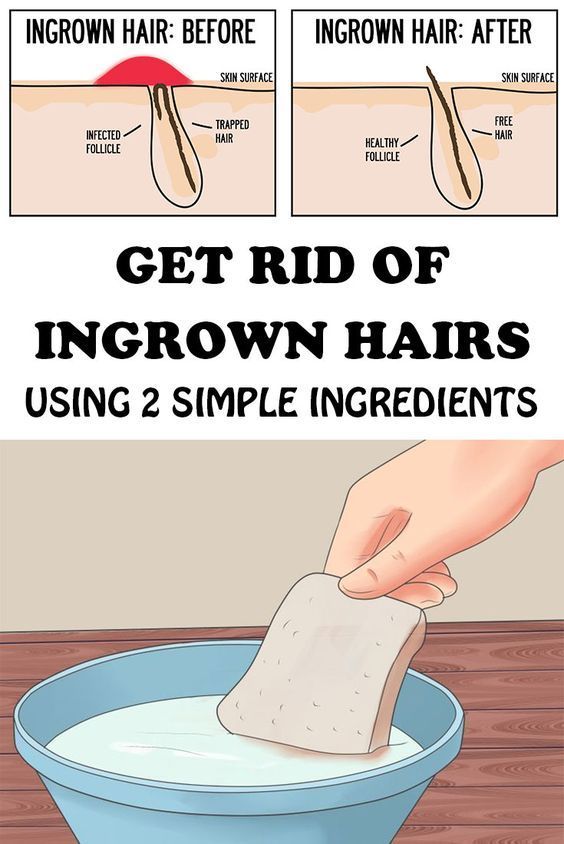 Only by limiting reproduction can you effectively manage the population in a manner to provide long-term control. Over time, killing pigeons more closely resembles a harvest as opposed to an actual control program.
Only by limiting reproduction can you effectively manage the population in a manner to provide long-term control. Over time, killing pigeons more closely resembles a harvest as opposed to an actual control program.
CEO, Innolytics, LLC, (est. 2003) focused on developing contraceptive technology for the management of pest birds and other wildlife. Professional Experience
40+ years of industry experience (Crop Protection, Animal Health, Pharmaceuticals) US and International
Why do people want to get rid of pigeons?
Simply put, pigeons represent a threat to the property
- Pigeon poop is highly acidic and can stain and etch surfaces.
- Accumulated feces represent a hazard for people and property, especially your roof and automobile.
- Feces on a balcony or patio will stain and eventually damage outdoor furniture.
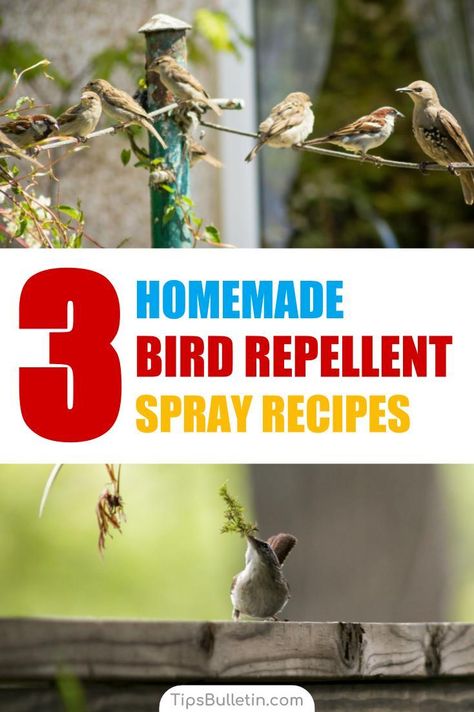
- Pigeons poop in their nest. Once dry, the feces bind the straw and debris into a structure that can last many seasons.
- Pigeon nests built in the dry season will often clog gutters when it starts raining.
How do I keep pigeons away from my vents?
The best way to keep pigeons from vents is with ½” metal screening.
Will aluminum foil keep birds away?
Yes, aluminum foil normally in shape of a pie tin can be effective in keeping birds from your balcony. The reflecting light is thought to disorient the birds.
Can you solve the pigeon problem yourself?
Yes, under the right set of conditions, you can do a DIY project. See the chart above.
What home remedy keeps pigeons away?
There are several home remedies that can be used on smaller pigeon projects, starting with harassment with an aluminum pie plate or CD’s that reflect sunlight. See the chart above.
15 Tips on How to Get Rid of Pigeons Fast [Humanely]
Let’s face it; pigeons have acidic waste, bullying attitude towards other birds, and the tendency to carry diseases.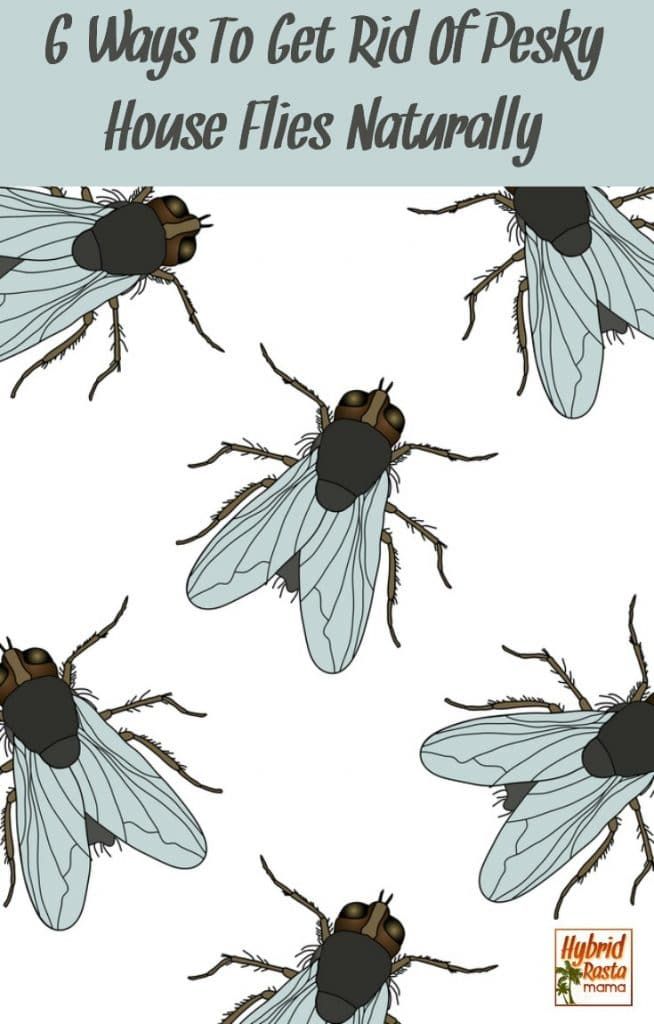 It feels like they just love to roost in every open spot around your garden.
It feels like they just love to roost in every open spot around your garden.
But everything is not lost; if you want to find out how to get rid of pigeons – you are in the right place. Here are the most effective pigeon control methods that you can implement in your own home right now.
1. Use an ultrasound pigeon repeller
Birds have a great sense of hearing, allowing them to hear sounds that human ears cannot detect. They need to have sharp ears to hear the calls of other birds.
This helps alert them to food, a potential mating partner, and danger. Use this to your advantage and get rid of pigeons with sound.
The Bird-X Balcony Ultrasound Bird Repeller can help remove pigeons from your property by emitting bird distress calls and sounds that predators make. It has several settings that allow you to mix several pre-recorded sounds, making it appear more natural.
This can be heard by birds within a 1-acre radius. Maximize the sound by installing the device in a high area. Pigeons that hear this will think that your home is dangerous and will stay away.
Pigeons that hear this will think that your home is dangerous and will stay away.
Other kinds of pigeon control devices that use sound to get rid of pigeons use frequencies that can only be heard by these birds. It is at a frequency that is lower than can be detected by human ears but sounds irritating to pigeon ears.
Note that sound-based pigeon control methods may not work immediately. Consistency is key. Leave it on for hours every day and for weeks to make sure that every time a pigeon visits your home, it hears the sounds. This way, it will learn to associate your home with danger.
2. Install a “scare-pigeon”
Pigeons are food for raptors such as falcons and hawks. Unfortunately, these powerful birds of prey cannot be hired to scare pigeons away from your home, but there is a good alternative: scare-pigeons.
Having a scare pigeon that is as life-like as possible is what keeps pigeons away. It’s best to get one that is 3D, life-size, and makes erratic movements or emits the raptor sounds.
But no matter how real it looks and acts, pigeons will eventually get in on the joke if it stays only in one place. Move scare-pigeons from place to place to trick the birds into thinking they’re real.
If you want to stop that pigeon in its tracks, you might want to go for the Dalen Gardeneer Solar Owl. This is a realistic owl figurine that uses solar energy to rotate its head.
It’s eerily similar to how a real owl would scout its surroundings–making it perfect for scaring away those pesky birds. This scare-pigeon is lightweight, so you will need to secure it so that it does not get knocked over by the wind.
You can do this by putting sand inside the figure through the hole at the bottom. Then seal it with the plug that comes with the figurine. Alternatively, you can insert a 1 ¼” PVC pipe and secure that to a wooden board or anything heavy.
3. Use reflective surfaces to deter pigeons
Desperate to keep pigeons off the balcony? Have you got pigeons on the roof pooping all over your home? If you want to get rid of birds around your house without spending a lot, just look for anything that reflects light.
Birds, in general, do not like bright flashes of light. Avian eyes react to the prism effect, leaving birds feeling disoriented.
The good thing is, this principle can be applied with a variety of things lying around your home or going for cheap in your local department store. Old CDs, small mirrors, aluminum foil strips, foil balloons, or outdoor reflective tape are some popular choices.
Hang them from a string and position them wherever you see pigeons hanging out. As they move with the wind, these catch the light and scare pigeons away.
If you are going for convenience and low maintenance, try the De-Bird Reflective Scare Tape. This is among the most popular bird deflectors because it catches the light very well and crackles loudly in the breeze.
A single roll carries 350 feet of tape so it can cover a large area. It’s best to cut out strips 16-18 inches long. Tack them on vertical surfaces near where pigeons like to roost, or else hang them from a string and let them flap in the wind.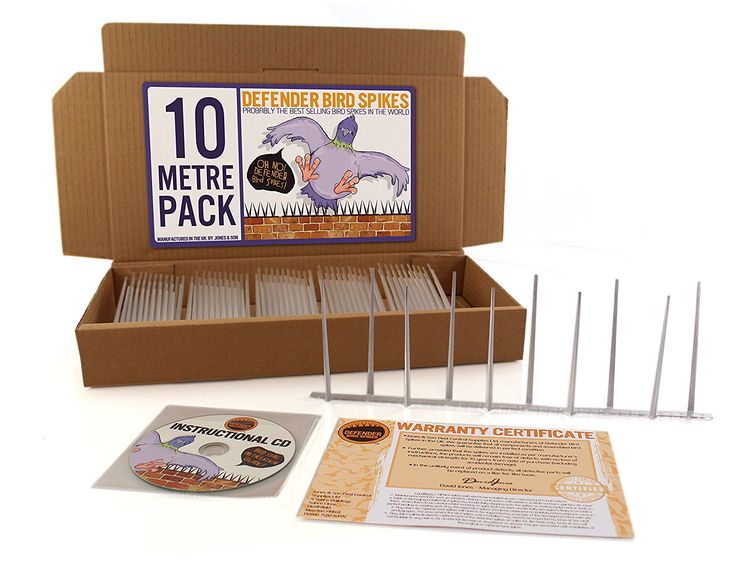 They last for months, but you can easily replace them by cutting another strip.
They last for months, but you can easily replace them by cutting another strip.
4. Install anti-roosting spikes
If you want to protect your ledges from pigeon roosting, anti-roosting spikes are a good option. By minimizing areas where they can get a foothold, you make your home a less viable option for pigeons to hang out in.
The Bird-X Bird Spikes Kit is popular because it has protrusions that make it difficult for large birds to sit.
The plastic polycarbonate material is durable, long-lasting, and requires little to no maintenance. It’s also clear-colored, making it difficult to notice from a distance. This way, it does not hamper the aesthetics of your home.
You will need to measure the areas where you plan to install it to know how many kits you will need. Each kit comes with 10 pieces of 1-foot long spike segments that can cover 5-10 linear feet of ledge space depending on how widely you space them apart.
You may opt to use the special adhesive glue that comes with the kit, or you can attach it using nails, screws, or tie-downs. This is a good way to keep pigeons away from horizontal surfaces, but note that these birds are smart.
This is a good way to keep pigeons away from horizontal surfaces, but note that these birds are smart.
They will learn to avoid the places where the spikes are installed. When it is placed along horizontal surfaces under a roof or against another wall, there is a possibility for birds to use these to make nests. Therefore, pigeon spikes are best installed on ledges that are open to the sky.
5. Apply a pigeon repellent gel to roosting areas
If you are scratching your head over how to get rid of pigeons on your roof, remember that you need to make it less attractive to them. You can do that by making their roosting areas untenable with pigeon repellent gel.
Bird-X Bird Proof Repellent Gel is among the most popular on the market. This comes in three caulk tubes that each can cover an area of about 10-12 feet.
Load the caulk tube into your caulk gun and apply easily in lines or in dots. Birds that land there will realize the surface is very sticky and leave immediately.![]()
This is a non-toxic petroleum-based gel that stays sticky for weeks in different weather conditions. Since it’s a clear gel, it’s barely noticeable. Use this to keep pigeons off the roof and other places that humans and pets do not frequent.
Not the best idea to use this to get rid of pigeons on balcony or on any railings, window sills, or landings that people touch, as the bird repellent gel is very sticky and difficult to remove.
This is a safe way to get rid of pigeons without hurting them, but following instructions properly is key. Avoid heavily smearing an entire surface with the gel as birds can get stuck and hurt themselves.
6. Install a motion-activated sprinkler
If you want to know how to eradicate pigeons from your yard and stop the pigeon poop from raining down your garden, consider using a motion-activated sprinkler. An unexpected spray of water is among the most humane and non-toxic ways to get rid of pigeons.
The Orbit 62100 Yard Enforcer is a motion-activated sprinkler designed to help keep your garden well-watered and well-protected from pests.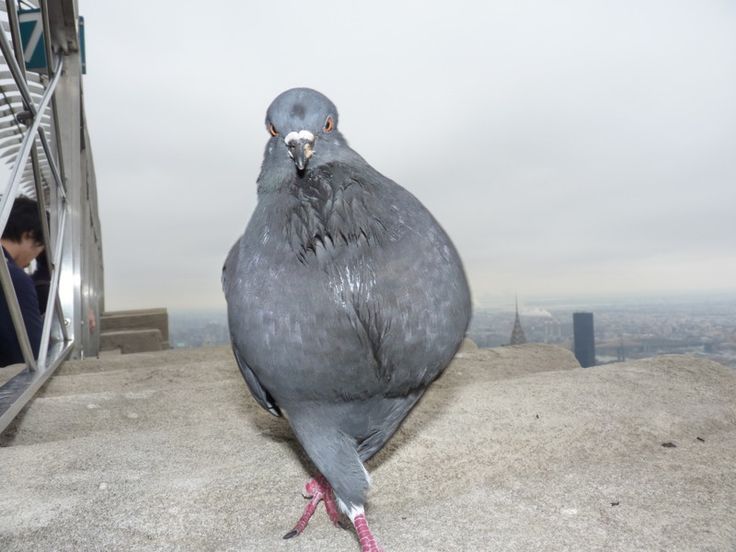 It uses a combination of water, sound, and movement to scare pigeons and other unwanted guests away.
It uses a combination of water, sound, and movement to scare pigeons and other unwanted guests away.
This has a wide range of settings so you can adjust according to your pigeon pest control needs. The sensor can be adjusted upwards for birds and is able to detect movement from 40 feet away.
The spray protects 1600 square feet of space, although you can make the range of motion more narrow to avoid garden paths and other things you wouldn’t want to be watered. It has a smart sensor that can tell if the movement is from an animal or from the wind. It will only get triggered by the latter.
Plus, you can customize the settings such that the sprinkler will only work during the day, or only during the night, or 24/7. Just attach it to a hose as you would a normal sprinkler, and bury its dual-step spike into the soil. Adjust the settings, and you’re good to go!
7. Test out a bird shock tape
An efficient pigeon removal method is to deliver a shock to make the birds fly off.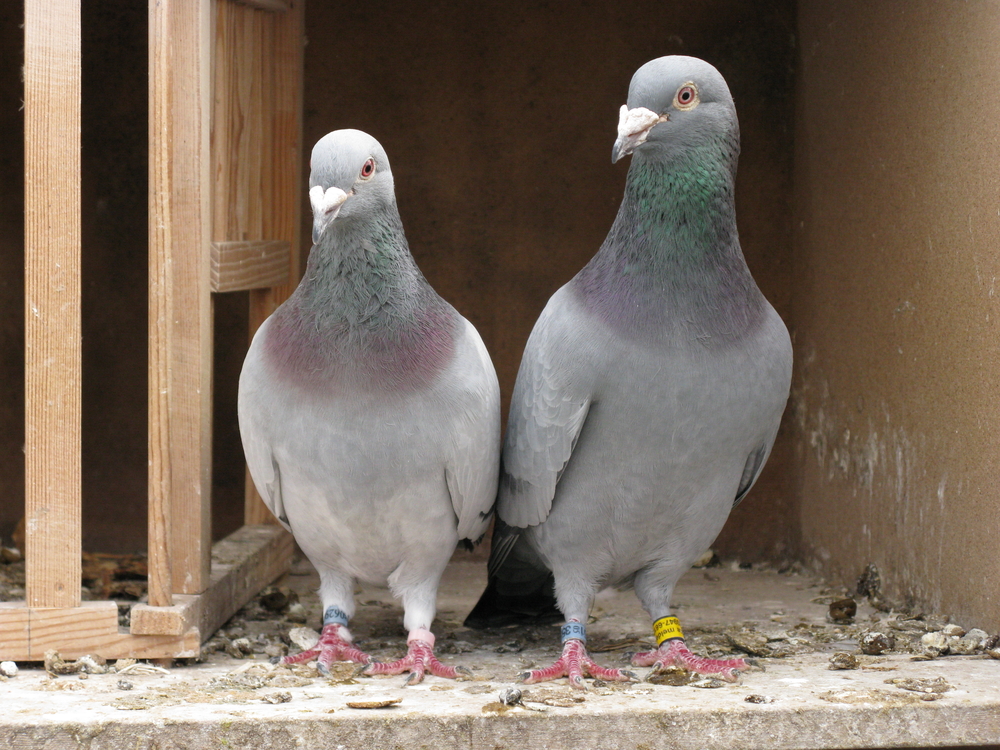 An easy and relatively inexpensive way to do this is to use bird shock tape.
An easy and relatively inexpensive way to do this is to use bird shock tape.
Make Em Move Shock Tape is a 50-foot roll of clear tape that has the ability to conduct electricity. It is able to do so because it has three metal leads running through its length.
Like your typical school supply tape, all you need is to peel it off the roll, stick to the surface of your choice, and smoothen it out.
Charge it with a standard 110-volt charger or a solar charger. Once charged, this becomes a formidable pigeon control device. The birds do not realize that there is tape on the ledge on account of its transparent color.
As they land and perch, their feet touch the deterrent strips. Immediately they will receive a small and short electric shot. The pigeons are literally jolted out of the position by the electric current. A couple more instances of this and they will learn to avoid your home.
The pigeons are literally jolted out of the position by the electric current. A couple more instances of this and they will learn to avoid your home.
The Bird Barrier Bird Shock Charger is a way to charge your bird shock track. It powers around 200 feet of track. Place 2 D-cell batteries in, attach it to your track, and that’ll be enough to power it for up to two months.
8. Install a weatherproof string
A weatherproof string is another way to deter pigeons from roosting near your home without hurting them. These fine, almost invisible pieces of string are stretched taut over favorite perching spots.
When the birds swoop in to hang out in your house, they grab the ledge with their claws and find themselves reeling at an unexpected surprise. They are caught off-balance because of something they cannot see properly and become wary of roosting in that spot.
Who would have thought that such a simple method could be so helpful in pigeon proofing your home?
This principle of using a bird deterrent wire will work with any rope or thread, but if you do not want to be inconvenienced by replacing it over and over again, you should go for a weatherproof string.
As the name implies, it can withstand the elements. It is also designed to be strong enough to resist the force of a pigeon swooping into the land.
Just tie the string such that it is an inch or so above the surface you are trying to discourage pigeons from perching on. Make sure it’s taut and tied up well on either end. Check it every couple of weeks to make sure it’s still standing.
9. Eliminate food sources
There are some instances when a pigeon infestation refuses to go away, even if you try multiple methods of pigeon deterrence.
No matter how many bird deflectors for windows you install, no matter how liberally you douse your home with pigeon repellent spray, no matter how often you climb up the roof to get rid of pigeon nest, they just keep coming back.
Oftentimes, this happens because they have a strong enough reason to. So if you want to find out the best way to get rid of pigeons in your home, you have to first understand what they’re doing there in the first place.
The presence of food is a strong enough motivator for pigeons to return to your home and ignore all the pigeon deterrent devices and pigeon deterrent sprays.
These birds are strongly attracted to berries, seeds, grains, beans, and fruits. Earthworms, snails and other insects make for an occasional snack. In urban settings, pigeons can become scavengers, congregating around trash bins with human food in them.
Observe the pigeons in your home. Are they congregating around certain trees or bushes? Is there something on the ground they are pecking at? Do they hover around the trash? Dedicating a couple of minutes every day to observing their habits can tell you a lot about how to get rid of them.
10. Seal off ALL the entrances
Pigeons like to nest in corners where they can get protection from the sun, the cold, and predators. Take a walk around your home to pinpoint places that pigeons would love. Preventing access to these areas is a helpful way of getting rid of pigeons.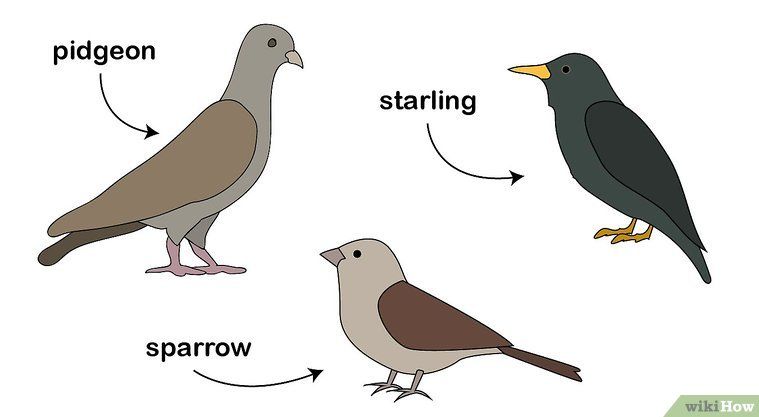
There are a lot of ways to do this using items found in the home improvement section and hardware stores. You can use silicone caulk to fill in small openings.
Use hardware cloth if you want to cover a bigger area. Bird or pigeon nets can be hung around the space above rafters to prevent them from making their home there.
Birds love attics, so it’s good to pay special attention to that part. Prune the tree branches that graze your walls, as this can encourage roosting and nesting near your home.
If you’ve had pigeon nests in your home before, it’ll be much easier to know where to focus. Clean out the old nests and waste, and seal off that area with pigeons netting.
This is best done in conjunction with other pigeon control methods. Making your home untenable for these birds is the first step to getting rid of them.
11. Remove the bird bath
You may have put out a bird bath to attract beautiful birds into your garden, but you’ll have to remove it if you’ve got pigeons nearby.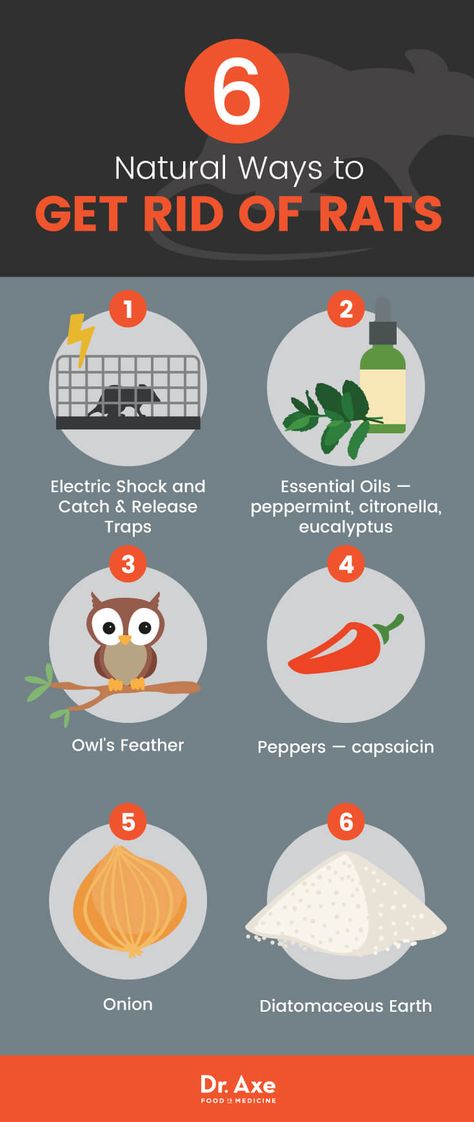
Pigeons are not water birds, but they do enjoy a good bath. They do it to maintain good feather condition and to cool down during hot days.
But once your bird bath has been invaded by a flock of pigeons, you can be sure they’ll bully other birds away so only they can use it.
In this case, it’s time to drain out the bird bath. These only make your home more attractive to these pests.
Consistency is key here, so make sure it stays empty by removing water after it rains. With the pigeon bathtub gone, it’s one less reason for them to stay.
Also, check around your property for things that might serve as a bird bath. Shallow containers of water uncovered by a lid or a shallow hole in the driveway where water puddles form may also serve as bird baths.
12. Install a pigeon net
When you realize the garden harvest you work so hard for has been devoured by pigeons, it’s easy to understand why you want to get rid of pigeons with poison or anything that will cause them pain.
But we must remember that there are ways to get rid of pigeons without hurting them. There’s no need for pigeon extermination and other lethal methods to get rid of these birds if you can prevent them from landing on your plants at all–which is the point of pigeons netting.
This is the best pigeon deterrent that will protect the hard work you’ve put in your garden. It is best to install it on thin rods instead of thick planks of wood, as the latter can serve as a roosting area.
Make sure to leave a space of at least 6 inches between the netting and the nearest branch or shrub to prevent birds from picking at it through the mesh. Install it at a steep angle so that pigeons won’t be tempted to land on them.
The De-Bird Heavy Duty Bird Netting will work well against larger birds such as pigeons. It is made of polypropylene, a durable but lightweight material that allows for easy handling and long-lasting protection. It is resistant to rot and can work through different weather conditions.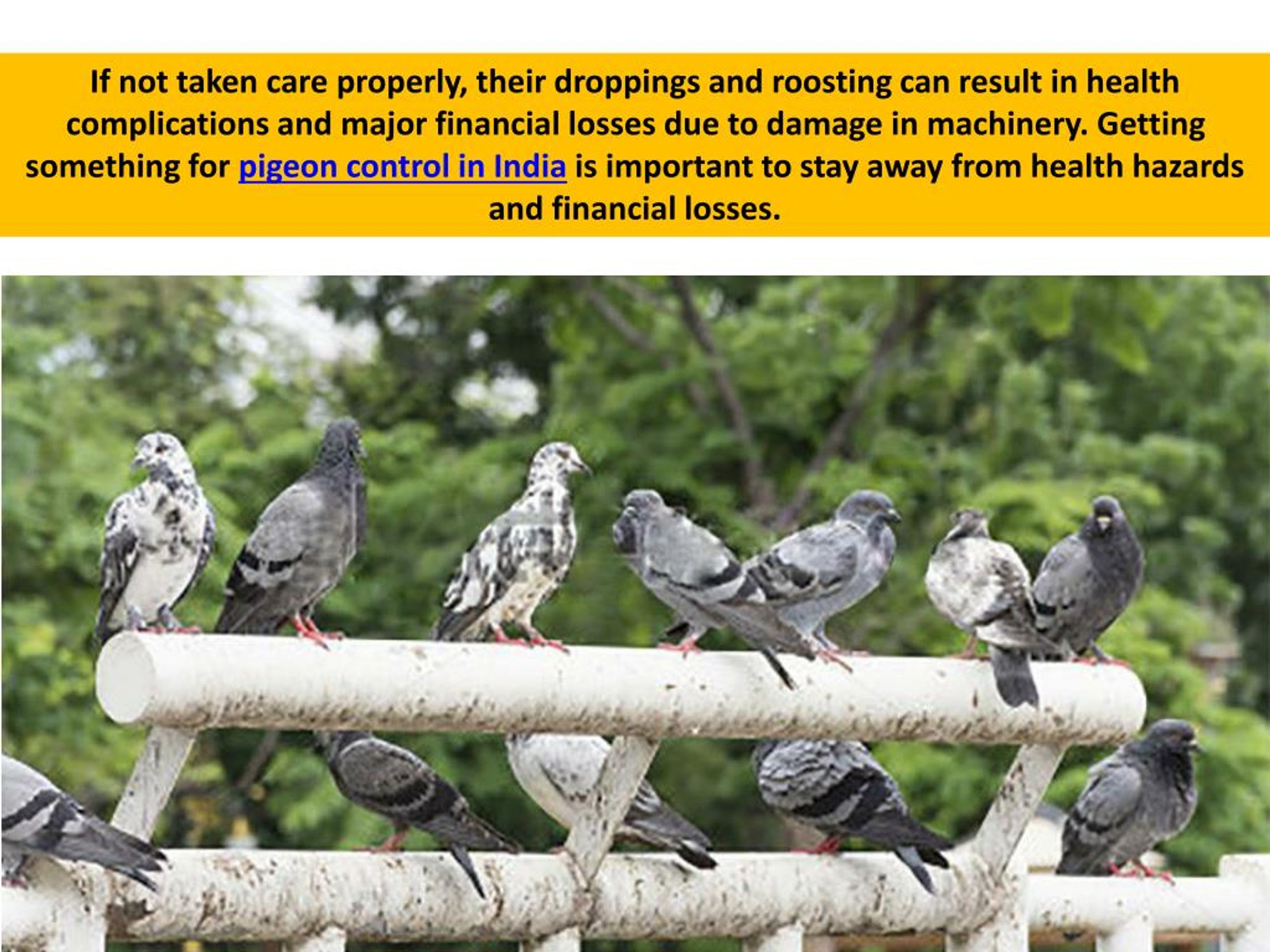
13. Cap your chimney
The chimney deserves a separate mention because it’s among the top bird-friendly places in a house. They love to roost and nest in this area, which makes it difficult for people to get them out. Before you cap your chimney, first make sure that there are no birds trapped inside.
If there is, you can coax it out by putting a cardboard box inside the fireplace, with its opening facing up towards the ceiling. Make sure it fits snugly to ensure that the pigeon won’t have anywhere else to go but inside the box.
Pull it out just enough so that you can insert a flashlight in. Shine it on the bottom of the box and put it back in. The light should attract the bird to fly down the chimney and into the box. It may take some time to do this yourself. If it is not successful, it is best to call an expert.
Once you’re certain there are no birds or nests stuck in your chimney, you can proceed to cap it. There are many chimney caps on the market that will fit any home aesthetic.
Note that caps with smaller mesh holes are more effective at keeping animals out, but they also require more maintenance. Ash, soot, and creosote can fill up these spaces quickly, so you will need to check it every so often to make sure it’s still clear.
14. Remove nesting materials and pigeon droppings
Whether you plan to use pigeons netting over your garden, use sprinklers as a natural pigeon deterrent, or hang streamers of reflective tape all over your house, there is one thing you should do before attempting any pigeon control methods: And that is to clean out all the pigeon nests and droppings in your home.
Remember that pigeon poop is particularly corrosive. It is highly acidic because of the uric acid content. This allows it to destroy a different building and roofing materials.
It can also be a source of zoonotic diseases that are transferable to humans. Remnants of pigeon nests should also be removed to make it easier to install deterrent devices such as netting, shock tape, and other fixtures.![]()
It is best to wet pigeon droppings before removing them to minimize dust. Wear a dust mask to be extra safe.
Use warm water through a hose or power sprayer to remove them easily and to minimize contact. Soap can also help loosen them up. If you are cleaning poop off your roof, place a tarp on the ground below to catch the waste.
15. Trap and release
You might consider trapping pesky birds and releasing them a good distance away. Note that this may not be the best way to get rid of pigeons because some species have a strong homing instinct. It will take a long drive away from home to be successful.
To successfully lure pigeons, place the trap somewhere they frequent, far away from any natural pigeon deterrent or pigeon repellents that you might have installed before.
For at least seven days, put bird feed inside and allow them to come and go as they please. More and more birds will come in as they realize there are free food and drinks. This will help the flock think that the area is safe.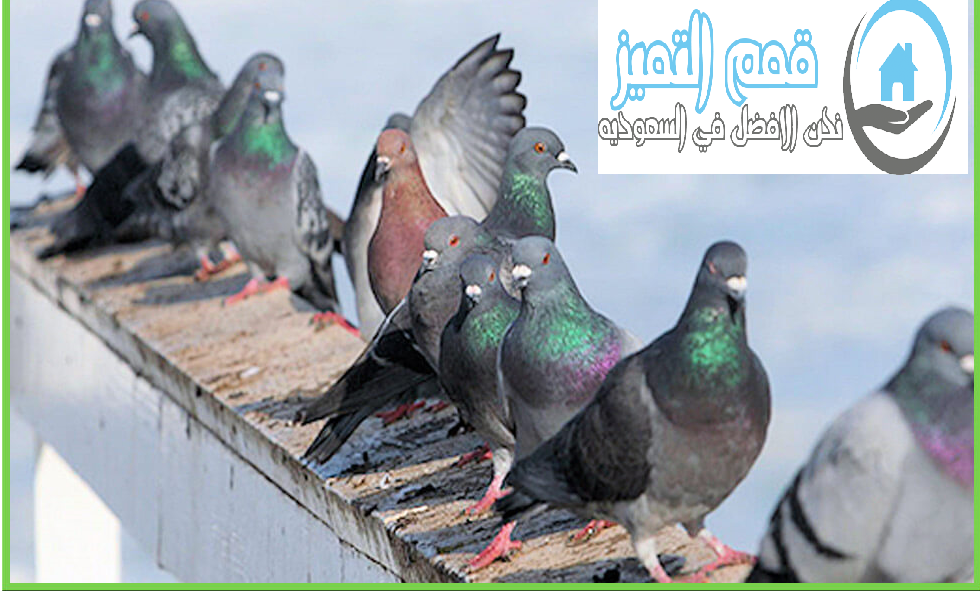
You can catch them using the Bird Barrier Pigeon Trap. This is designed specifically for trapping pigeons. It is designed to accommodate 10 live birds.
With a built-in drinker and a removable cover for shade, it minimizes harm done to the birds from trapping to freeing in the wild. Entry is made easy with four openings, but escape is made near impossible with the slanting walls and strong mesh.
Once full, take the cage and drive to a location at least 5 miles away (the farther, the better). Open the spring-loaded door at the top of the cage, and watch the pigeons fly off into their new home.
Related:
- Dove Symbolism & Meaning (+Totem, Spirit & Omens)
- 15 Tips on How to Get Rid of Starlings Fast [Humanely]
- 15 Tips on How to Get Rid of Barn Swallows [Humanely]
- 15 Tips on How to Get Rid of Grackles Fast [Humanely]
why they fly in, how to scare away with glare, scare away with ultrasound and drive them away forever
We live on the last floor, and pigeons have overcome us: they fly to the unglazed balcony, and also sit on the window sills from the side of the street and coo for whole days.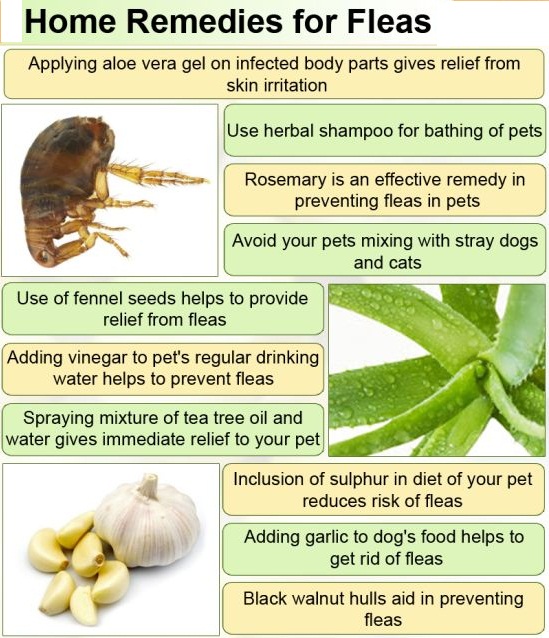 It seems to be quiet, but terribly annoying. Especially in the summer when the windows are open. At night, you can clearly hear the birds stamping their feet on the metal window sills. This is real torture!
It seems to be quiet, but terribly annoying. Especially in the summer when the windows are open. At night, you can clearly hear the birds stamping their feet on the metal window sills. This is real torture!
We tried to throw the cat on the balcony, but on the second day he almost fell down when he chased the dove. The cat was removed so that there were no unnecessary victims. I don’t want to poison the birds either: it’s a pity.
Is there a humane way to get rid of pigeons?
Andrey Nenastiev
lives in harmony with nature
Author Profile
Pigeons are not that hard to deal with, but you may have to try several methods until you find a truly effective one. I will not talk about deliberately cruel methods: persecuting birds with chemicals or installing nails on window sills with the point up. You can do without it.
Why doves appear on the balcony
Pigeons, as a rule, do not fly to balconies and windows just like that. There are several reasons why they visit you:
There are several reasons why they visit you:
- Someone is feeding pigeons, including by accident. For example, a neighbor on the floor below in the summer brings water and food for the dog to the balcony, and the leftovers attract birds.
- There is a lot of rubbish on the balcony, in which it is convenient to make nests or hide from bad weather.
- Near the balcony there are comfortable places for birds to rest. If you live on the top floor, the pigeons are probably attracted not so much by the balcony itself, but by the openings of the ventilation shafts or the space under the roof canopy where you can climb.
How to keep pigeons away with glare
One of the easiest solutions to fight pigeons is glare: pigeons hate bright reflections. There are several ways to create them.
Cut strips of foil and hang them around the balcony to blow in the wind. You can also stick foil sheets inside or outside the balcony.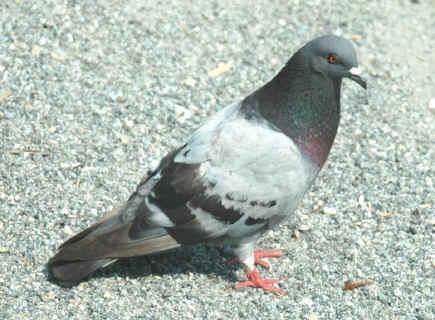 This must be done carefully so as not to fall. It is better to buy stronger foil, you can still use candy and chocolate wrappers.
This must be done carefully so as not to fall. It is better to buy stronger foil, you can still use candy and chocolate wrappers.
Use foil insulation - foil insulation. It is sold in rolls at hardware stores. This material is much stronger than foil and will not deteriorate from rain and wind. Folgoizol can be glued to the walls on mounting foam, fixed with roofing screws or bars. The last method is the most correct and reliable.
Hang old CDs on the balcony. They will spin in the wind and glare.
If you decide to glaze the balcony, you can leave foilizol - it will work as a heater. Source: Balconies and Windows CDs are pierced with a nail and hung on wire or rope. Source: "100 Hares"Paint the window sill with paint that shines in the sun.
Place a large mirror on the balcony. True, the mirror will give glare only in one direction.
Hang balloons with glitter on the railing. Ordinary balloons will burst quickly, helium balloons will last a little longer, but they are also short-lived.
Ordinary balloons will burst quickly, helium balloons will last a little longer, but they are also short-lived.
Use a laser pointer. Pigeons are scared by a laser beam. This method is ineffective, since the battery in the pointer will quickly run out, especially if you keep it on the balcony in the cold. It is better to use a pointer to drive the pigeons by hand without getting up from the sofa.
How to scare pigeons
Most likely, the same pigeons fly to the balcony and windows every day, not different ones. To drive the birds away from their usual place, you need to intimidate them. Here's how to do it.
Water the pigeons. They don't like to be wet: it's so hard to fly. Birds can be watered with a water gun or a spray bottle if you can get close. You can also extend a garden hose: connect one end to a tap, and fix the other end to a balcony and attach a sprinkler. When the pigeons arrive, turn on the faucet. You may have to water the pigeons for more than one day until they develop a reflex: it is dangerous to sit here - you will get wet.
But there is a problem: you have to be at home when the pigeons arrive. If you only come in the evening, and the pigeons are circling all day, this method will not help.
To scare with sound and ultrasound. Pigeons cannot stand heavy music, rustling and sounds of birds of prey. They say it's good to include AC/DC recordings interspersed with a hawk's call. It takes time for this to work - maybe a few days. After such methods, the pigeons may disappear, but it is not clear how all this will affect the psyche of the neighbors.
There are acoustic bird scarers that operate in the ultrasonic range. A person does not hear ultrasound. Manufacturers claim that such devices scare away birds on approach, but there is no unequivocal opinion about this: some work, some do not.
Ultrasonic bird repellers cost around 2000 R. Source: Yandex Market Set up a scarecrow. You can put a scarecrow in the form of a bird of prey - a hawk or a falcon.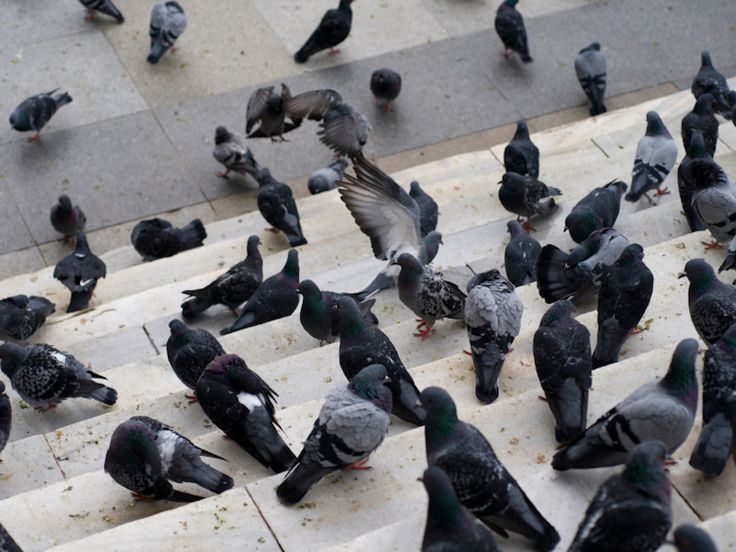 Pigeons also do not like crows and never live next to them, so a stuffed crow is also suitable.
Pigeons also do not like crows and never live next to them, so a stuffed crow is also suitable.
The scarecrow must be large - at least half a meter high, otherwise the pigeons will not be frightened.
If you are too lazy to look for a stuffed bird or they are too expensive, a large soft toy with glass eyes will do. It is advisable to rub the eyes to a shine so that they imitate the gaze of a predator.
There are also such balls with imitation of the eyes of a bird of prey. Photo editor T-Zh Maxim Koposov says that only the vinyl ball helped him cope with the pigeons. You can buy stuffed birds of prey at Ozone Stuffed birds of prey can be found at Avito. They are often sold by huntersHow to prevent pigeons from landing on the balcony
You can physically restrict the landing of birds on the structure of the house. The most obvious way is to glaze the balcony and reduce the width of the window sills. But this is not always possible. Here are cheaper and less time-consuming ways.
Cover the balcony with a net. Polymer nets are sold in gardening stores. It is better not to use fishing nets, as the birds will get tangled in them, and there will be even more noise.
To close the middle balcony, a polymer mesh will be required for 1000-1500 R. Source: "Satom"Pull ropes on window sills. Ropes or fishing lines are stretched just above the surface of the window sill so that it cannot be landed on. It is not difficult to do this on the balcony railing, but it is dangerous to stretch the line, leaning out of the window of the ninth floor.
Lubricate window sills with Vaseline. The idea is to make the pigeons' legs slide off the surface when the birds try to sit down. In addition to vaseline, vegetable oil and PVA glue are used. The method is simple, but ineffective: the funds will quickly be washed away by rain, and you can also ruin the window sills.
Install anti-additive barrier. This is a professional bird control sticky tape with spikes. Despite the threatening appearance, such a tape does not harm the birds.
This is a professional bird control sticky tape with spikes. Despite the threatening appearance, such a tape does not harm the birds.
Other methods
In addition to the above methods, pigeons can be repelled with the help of smells. Cloves, black or red pepper, cinnamon are scattered across the balcony. Some use naphthalene. There are also special sprays based on essential oils to scare away birds. All this is short-term: smells on an open balcony or window sill will quickly disappear.
The idea of letting the cat out on the balcony is dangerous for the cat. This method works well only in combination with a polymer mesh. The net will prevent the pigeons from landing and will not allow the cat to fall out of the balcony in the excitement of hunting. At the same time, the cat will be able to drive away the birds on the way.
How to deal with pigeons
- Pigeons will stop coming if it is inconvenient for them to land.
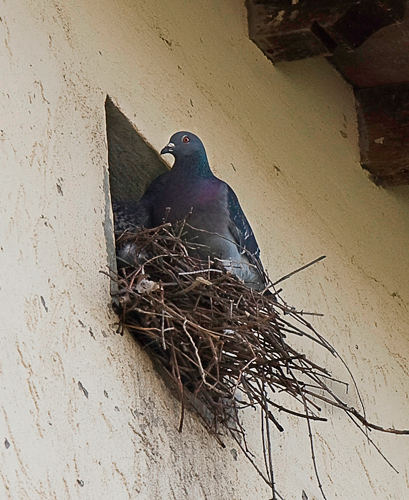 Stretch the fishing line on the balcony, and install the tape with spikes on the window sills.
Stretch the fishing line on the balcony, and install the tape with spikes on the window sills. - Hang old discs, foil or other materials on the balcony that create glare. Pigeons don't like that.
- You can spray birds with water or scare away with ultrasound. But the first, most likely, will not be appreciated by passers-by, whom you risk accidentally pouring.
- It's better to leave the cat as heavy artillery when you pull the line.
What to do? Readers ask - experts answer
Ask your question
How to quickly get rid of pigeons on the balcony
Pigeons on the balcony are a common problem for residents of apartments and even private houses. Birds periodically arrive in search of food, hide from the rain, and sometimes even build nests.
In this article we will tell you how to get rid of pigeons on the balcony, why they arrive at all and what danger it brings.
Why pigeons fly to the balcony
Before fixing a problem, you need to understand its causes.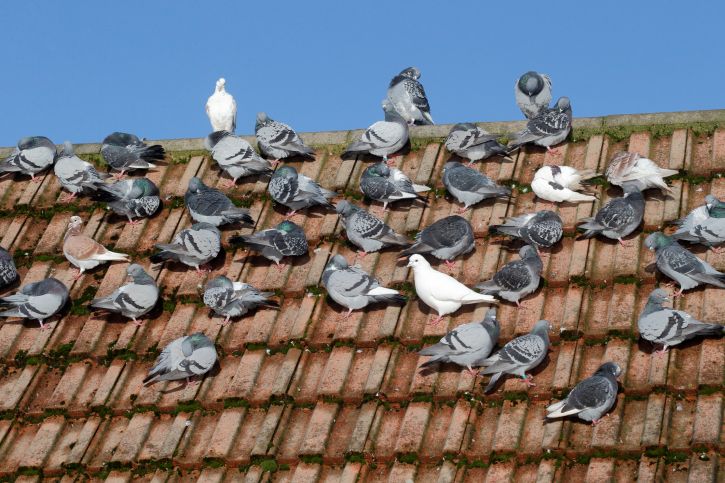 In the case of pigeons, there are several.
In the case of pigeons, there are several.
- The balcony is neglected or very cluttered. It is very convenient for birds to make nests in the trash among things. It is also a good place to hide from the rain.
- The balcony is located on the last floor. Pigeons love to live under rooftops, in attics and in ventilation shafts. They also like to sit in comfortable places near their homes - which are the balconies on the top floor.
- Neighbors out of kindness or unintentionally feed pigeons. For example, they feed their pets on the balcony. Crumbs and what the animal has not eaten attract birds, including to neighboring balconies - pigeons know that there is something to eat nearby and are looking for food.
- Sometimes people store some food on the balcony. This also attracts birds.
If the problem is in the balcony itself, you need to remove the rubbish or stop storing food on it. If the reason is in the neighbors, it is worth talking to them.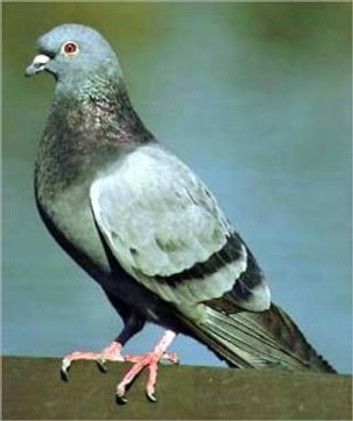
Also, keep in mind that open unglazed balconies attract the most pigeons. Therefore, it may be worth thinking about glazing it.
How dangerous is the neighborhood with pigeons
Pigeons are carriers of serious infectious and viral diseases that are dangerous to humans. Among them are pseudotuberculosis, ornithosis, salmonellosis, tularemia, toxoplasmosis, etc. Such diseases occur with fever, sometimes with diarrhea, and can cause serious complications.
Pigeons carry fleas, ticks, bed bugs and other insects. If birds often stay on the balcony, then all these parasites can easily enter the apartment.
Faeces damage the finish of the balcony and are quite difficult to clean - often only repairs can save you from such pollution.
For these reasons, pigeons must be disposed of as soon as possible. And now we will tell you how to do it effectively.
How to chase pigeons off the balcony
Use a laser pointer
Pigeons are afraid of laser beams. Therefore, a laser pointer will be an excellent tool for scaring away pigeons from a balcony. And this can be done from the apartment - just shine on the birds through the window.
Therefore, a laser pointer will be an excellent tool for scaring away pigeons from a balcony. And this can be done from the apartment - just shine on the birds through the window.
Hanging a laser pointer on a balcony is not worth it - the batteries will run out quickly.
Spray the pigeons with water
Any spray gun or even a water pistol will do. Birds do not like water very much - that is why they often hide from the rain on the balcony.
Pigeons need to be watered for several days as soon as they arrive. After some time, the birds will develop a reflex that you can’t sit on this balcony, because you can get wet there.
Scare pigeons with loud noises
Even city pigeons don't like loud and unexpected sounds. Therefore, you can put a speaker on the balcony and turn on the music, or better, the sounds of the cries of birds of prey - a hawk, an eagle, etc.
To discourage pigeons from landing on your balcony, turn on different sounds for several days in a row.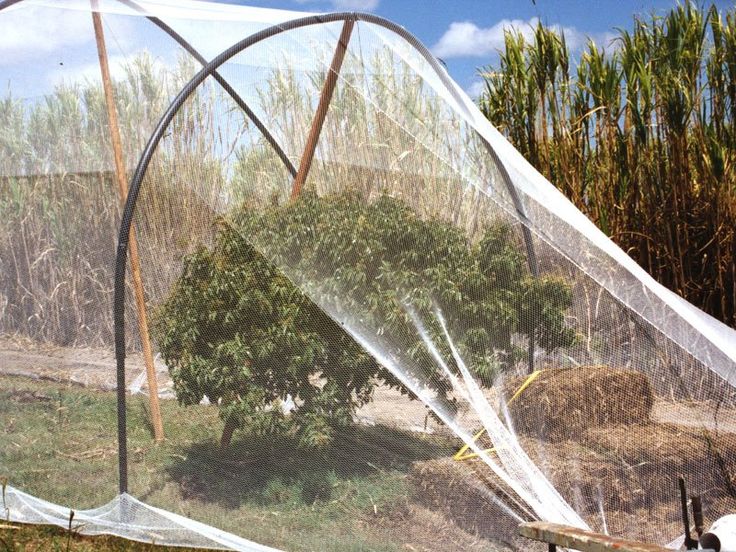 But how the neighbors will react to this is unknown.
But how the neighbors will react to this is unknown.
These three ways will help keep the pigeons off the balcony. But they have a drawback - you always need to be at home. If the birds sit on the balcony all day, and scare and chase them only in the evening, there will be no sense in such methods.
How to get rid of pigeons on the balcony permanently
Most likely you need to get rid of pigeons permanently. There are several proven ways to do this.
Place shiny objects on the balcony
Pigeons do not like shiny and shiny things. Therefore, on the balcony you can hang:
- foil strips
- candy wrappers
- old CDs
- glitter balloons
You can also put a large mirror on the balcony. Or finish the walls with foil insulation - foil insulation, which also gives good glare.
Or finish the walls with foil insulation - foil insulation, which also gives good glare.
Install the dummy
A dummy hawk or falcon is best suited for this purpose. It can also be a crow, which pigeons are afraid of. You can buy such products on the Internet, for example, in Yandex.Market.
The scarecrow must be large, otherwise the pigeons will not be afraid of it. It is desirable that the wings are spread - as in flight or attack. That is the maximum of realism.
It is best to buy a hawk or a falcon - it is beautiful, spectacular and guaranteed to scare away pigeons.
Stretch the line
If the birds constantly sit on the windowsill, balcony railing, in these places it is worth pulling the line. Pigeons will never gather where it is impossible to land properly.
You can also use thicker threads, but still the fishing line is better, as it is transparent and hardly noticeable.
Install additive barriers on the balcony
An additive barrier is a special device with spikes that prevents birds from landing where it is installed. The thorns are not sharpened, so they do not harm the birds.
The thorns are not sharpened, so they do not harm the birds.
Such barriers can now be seen at train stations. They are specially installed so that pigeons do not spoil the facades of buildings with feces.
Glazing the balcony
The most effective, but costly way to control pigeons on the balcony.
The entire balcony needs to be glazed. The ebbs and the visor on top are made of metal, narrow and at an angle, so that when trying to sit down, the birds simply slide off them.
Ready-made products for repelling pigeons
You can buy ready-made special products for repelling birds in stores and on the Internet.
Acoustic repellers
These devices make the characteristic sounds of birds of prey or the sounds that birds use to warn each other of danger. The second option shows the greatest efficiency.
The disadvantage of such devices is that they make noise that not only scares away pigeons, but also disturbs people. Therefore, it is more suitable for the balcony of a private house than an apartment.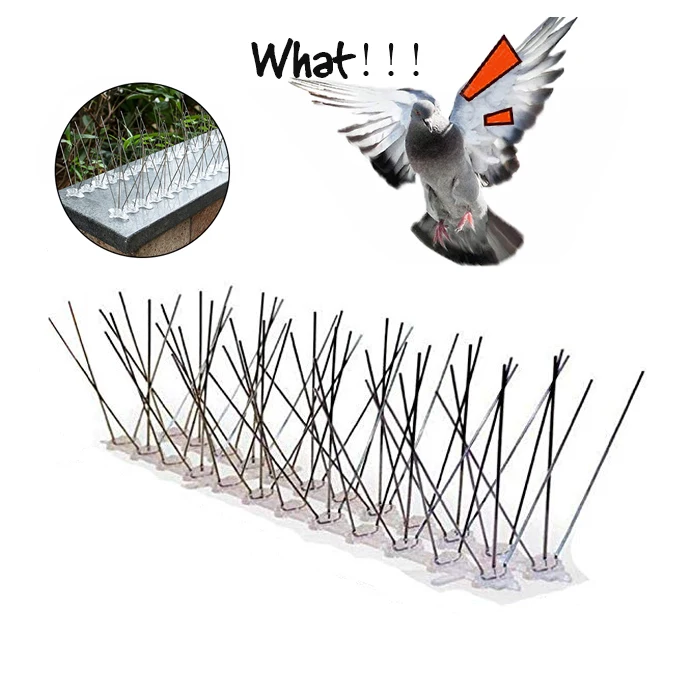
These devices operate on mains or batteries. Easy to install - easily attached to the walls of the balcony or the tree next to it.
Ultrasonic Repellers
Pigeons, like other birds, are very sensitive to ultrasound. They don't come close to places where they can hear it.
These units are self contained, compact, energy efficient and easy to install.
The disadvantage of ultrasonic repellers is that they cannot be used on the balcony of an apartment with pets. Animals also do not tolerate ultrasound.
Dynamic scarers
These scarers are one of the best options for a balcony because they don't disturb people because they don't make sounds. The essence of their work is to imitate the flight of a bird of prey - on the principle of a kite.
Models with large eyes on the wings are considered the most effective. And also on which there are drawings with a red border.
The installation of this repeller is simple and reliable, and maintenance is not required.
Visual repellers
Another good option for an apartment balcony. Because they do not make sounds and do not interfere with anyone. And they can also be a great addition to the interior of the balcony.
Such devices are as follows.
- 3D hanging balls. A special pattern is applied to them, which imitates the eyes of a bird of prey. The paint used is glare, which creates an additional deterrent effect.
- Figurines. They are made in the form of birds of prey - an owl, a falcon or an eagle. They can be hung on a fishing line, a strong thread attached to the balcony ceiling, or placed at a height - for example, on a shelf.
Acoustic and ultrasonic repellers are more suitable for balconies of country houses. Because they create noise that can disturb neighbors in an apartment building.
For the balcony of an apartment, the best option is a dynamic or visual repeller.
How to clean a balcony after pigeons
Cleaning a balcony after pigeons is a difficult task.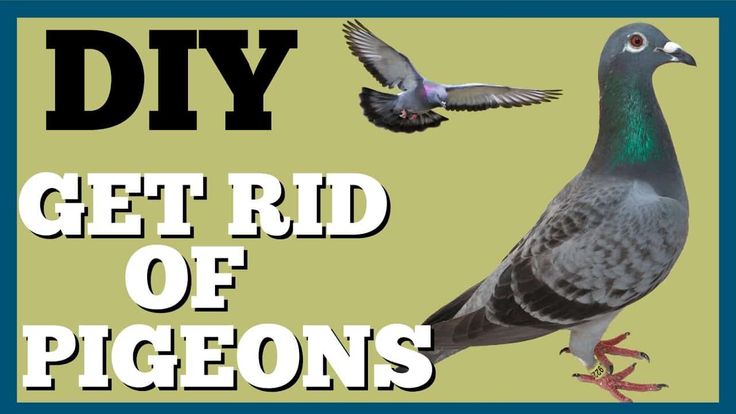 Because in addition to cleaning surfaces, furniture and things, disinfection must be done. As we mentioned above, pigeons are carriers of diseases and harmful insects. And there are dangerous organisms in the feces of birds.
Because in addition to cleaning surfaces, furniture and things, disinfection must be done. As we mentioned above, pigeons are carriers of diseases and harmful insects. And there are dangerous organisms in the feces of birds.
The cleaning itself is carried out in several stages:
- Removal of all belongings and furniture from the balcony. The necessary textile items can be washed well in the machine. Wash furniture thoroughly and disinfect well.
- Collection of large debris. All large debris should be collected and the nests, if any, should be discarded.
- Dry cleaning. Sweeping is not worth it, as this will raise dust with harmful bacteria that will penetrate into the apartment and to the neighbors. It is better to use a vacuum cleaner.
- Washing surfaces. Thoroughly wash the floors, ceilings, walls, window sills, windows, doors, etc. with detergents, preferably chlorinated ones. Because bird droppings damage almost all balcony finishing materials.

All work must be carried out with gloves, a respirator, goggles and a suit to exclude infectious diseases and poisoning.
The best option in such a situation is to contact a specialized company. Specialists will quickly and better cope with the cleaning and prepare the balcony for repairs and possible glazing.
For example, our company SpetsUborka cleans balconies after pigeons in St. Petersburg in the Leningrad Region. We work for the convenience of customers around the clock, every day and without prepayment. We have all the necessary equipment, machinery, chemicals and experienced cleaners.
Now you know how to get rid of pigeons on the balcony. The main thing, when the birds stop bothering you, is to clean everything up after them.
Services related to the article
Below are the services that you can order from us. We work in St. Petersburg and the Leningrad region. If you are from another region, we may be able to recommend a reliable partner.
